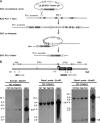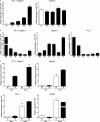OSTM1 bone defect reveals an intercellular hematopoietic crosstalk
- PMID: 18790735
- PMCID: PMC2662145
- DOI: 10.1074/jbc.M805242200
OSTM1 bone defect reveals an intercellular hematopoietic crosstalk
Abstract
The most severe form of bone autosomal recessive osteopetrosis both in humans and in the gray-lethal (gl/gl) mouse is caused by mutations in the Ostm1 gene. Although osteopetrosis is usually associated with a defect in the hematopoietic-derived osteoclast cells, this study determined that Ostm1 is expressed in many hematopoietic cells of the myeloid and lymphoid B- and T-lineages. Hematopoiesis in gl/gl mice is characterized by a marked expansion of the osteoclast lineage but also by deregulation of the lymphoid lineages with a decrease in B-lymphoid cell populations and altered distribution in T-lymphoid double and single CD4 CD8-positive cells. In committed gl/gl osteoclasts, specific Ostm1 transgene targeting showed a requirement of additional factors and/or cells for normal osteoclast function, and importantly, defined the gl osteopetrotic defect as non-cell autonomous. By contrast, gl/gl osteoclast, B- and T-lymphoid lineage phenotypes were rescued when Ostm1 is expressed under PU.1 regulation from a bacterial artificial chromosome transgene, which established an essential role for Ostm1 in hematopoietic cells in addition to osteoclasts. Together these experiments are the first to demonstrate the existence of hematopoietic crosstalk for the production of functional and active osteoclasts.
Figures





Similar articles
-
Ostm1 from Mouse to Human: Insights into Osteoclast Maturation.Int J Mol Sci. 2020 Aug 5;21(16):5600. doi: 10.3390/ijms21165600. Int J Mol Sci. 2020. PMID: 32764302 Free PMC article. Review.
-
Expression pattern of the V5-Ostm1 protein in bacterial artificial chromosome transgenic mice.Genesis. 2021 Mar;59(3):e23409. doi: 10.1002/dvg.23409. Epub 2021 Jan 23. Genesis. 2021. PMID: 33484096
-
Ostm1 Bifunctional Roles in Osteoclast Maturation: Insights From a Mouse Model Mimicking a Human OSTM1 Mutation.J Bone Miner Res. 2018 May;33(5):888-898. doi: 10.1002/jbmr.3378. Epub 2018 Feb 14. J Bone Miner Res. 2018. PMID: 29297601
-
Mutations in OSTM1 (grey lethal) define a particularly severe form of autosomal recessive osteopetrosis with neural involvement.J Bone Miner Res. 2006 Jul;21(7):1098-105. doi: 10.1359/jbmr.060403. J Bone Miner Res. 2006. PMID: 16813530
-
Infantile malignant, autosomal recessive osteopetrosis: the rich and the poor.Calcif Tissue Int. 2009 Jan;84(1):1-12. doi: 10.1007/s00223-008-9196-4. Epub 2008 Dec 12. Calcif Tissue Int. 2009. PMID: 19082854 Review.
Cited by
-
Managing challenging pain and irritability in OSTM1 mutation-related infantile malignant osteopetrosis.BMJ Case Rep. 2021 May 19;14(5):e242498. doi: 10.1136/bcr-2021-242498. BMJ Case Rep. 2021. PMID: 34011644 Free PMC article.
-
High-throughput screening of mouse gene knockouts identifies established and novel skeletal phenotypes.Bone Res. 2014 Oct 28;2:14034. doi: 10.1038/boneres.2014.34. eCollection 2014. Bone Res. 2014. PMID: 26273529 Free PMC article.
-
Ostm1 from Mouse to Human: Insights into Osteoclast Maturation.Int J Mol Sci. 2020 Aug 5;21(16):5600. doi: 10.3390/ijms21165600. Int J Mol Sci. 2020. PMID: 32764302 Free PMC article. Review.
-
Role of Ostm1 Cytosolic Complex with Kinesin 5B in Intracellular Dispersion and Trafficking.Mol Cell Biol. 2015 Nov 23;36(3):507-21. doi: 10.1128/MCB.00656-15. Print 2016 Feb 1. Mol Cell Biol. 2015. PMID: 26598607 Free PMC article.
-
Tolerant and Rapid Endochondral Bone Regeneration Using Framework-Enhanced 3D Biomineralized Matrix Hydrogels.Adv Sci (Weinh). 2024 Mar;11(9):e2305580. doi: 10.1002/advs.202305580. Epub 2023 Dec 21. Adv Sci (Weinh). 2024. PMID: 38127989 Free PMC article.
References
-
- Teitelbaum, S. L., and Ross, P. (2003) Nat. Rev. Genet. 4 638–649 - PubMed
-
- Boyle, W. J., Simonet, W. S., and Lacey, D. L. (2003) Nature 423 337–342 - PubMed
-
- Zaidi, M. (2007) Nat. Med. 13 791–801 - PubMed
-
- Janssens, K., and Van Hul, W. (2002) Hum. Mol. Genet. 11 2385–2393 - PubMed
-
- Lazner, F., Gowen, M., Pavasovic, D., and Kola, I. (1999) Hum. Mol. Genet. 8 1839–1846 - PubMed
Publication types
MeSH terms
Substances
LinkOut - more resources
Full Text Sources
Medical
Molecular Biology Databases
Research Materials

